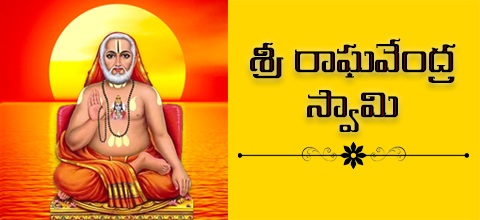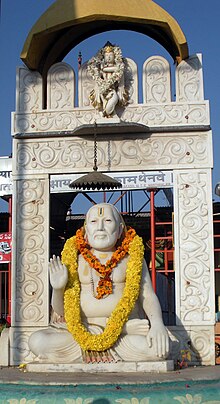 |
| Sri Raghavendra Tirtha |
Sri Raghavendra Tirtha was a Hindu scholar, theologian and saint. He was also known as Sudha Parimalacharya. His diverse oeuvre include commentaries on the works of Madhva, Jayatirtha and Vyasatirtha, interpretation of the Principal Upanishads from the standpoint of Dvaita and a treatise on Purva Mimamsa. |
Did you know?
Brindavan – The Sacred Burial
Mantralayam is famous for the holy presence of the Brindavan of Sri Guru Raghavendra Swamy. It is believed that Sri Guru Raghavendra Swamy will be in the Brindavan alive for 700 years and blessing the devotees. Also known as Rayaru and Guru Raya by his devotees.
The Grama Devata of Mantralayam is Goddess Manchalamma
Before the arrival of Sri Guru Raghavendra Swamy, the village was known by the name Manchali or Manchalaya because of the grama devata or the presiding deity of the village Goddess Manchalamma. Even today, before taking the darshan of Raghavendra Swamy, one has to first take the darshan of Goddess Manchalamma and only then proceed.
The Three Chariots
There are three chariots in the temple, one plated in gold, the other in silver, and the third in sandalwood. A new chariot is being made of Navaratha Stones (9 Precious Stones) which will be used for special occasions. The idol of the saint is carried around the temple every day.
The Miracle incident involving Thomas Munro and Sri Guru Raghavendra Swamy
Thomas Munro was the Collector of Bellary in 1800, the Madras Government ordered him to procure the entire income from the Raghavendra Swamy Matha and Mantralaya village. He was told that Sri Guru Raghavendra Swamy had been in Samadhi for nearly 130 years. Continue..
He visited the Math for investigation, removed his hat and shoes and entered the sacred precincts. Sri Guru Raghavendra Swamy emerged from the Vrindavan and conversed with him for some time, about the resumption of an endowment. The Saint was visible and audible only to Munro, who received Manthraksha (God’s blessing). Continue..
The Collector went back and wrote an order in favor of the Math and the village. This notification was published in the Madras Government Gazette in Chapter XI, page 213, with the caption “Manchali Adoni Taluka”. This order is still preserved in Fort St. George and Mantralayam.
His Life
Sri Raghavendra swami was born as Venkatanatha in the town of Bhuvanagiri, Tamil Nadu into a Deshastha Madhva Brahmin family of musicians and scholars. His great-grandfather Krishnabhatta was a tutor to Vijayanagara king Krishnadeva Raya, his grandfather was Kanakacalabhatta and his father Timmanacharya was an accomplished scholar and musician. After the fall of Vijayanagara empire, Timmanacharya migrated to Kanchi with his wife Gopikamba. Venkatanatha had two siblings: Gururaja and Venkatamba. Venkatanatha's education was undertaken by his brother-in-law Lakshminarasimhacharya at Madurai, after the early demise of his father, and he was subsequently married. |
His Work
Forty works have been attributed to Sri Raghavendra swamy. Sharma notes that his works are characterised by their compactness, simplicity and their ability to explain the abstruse metaphysical concepts of Dvaita in understandable terms. His Tantradipika is an interpretation of the Brahma Sutra from the standpoint of Dvaita incorporating elements from Jayatirtha's Nyaya Sudha, Vyasatirtha's Tatparya Chandrika and the glosses by Vijayendra Tirtha. |
In Culture
Raghavendra Tirtha has been eulogised by Narayanacharya in his contemporaneous biography Raghavendra Vijaya and a hymn Raghavendra Stotra by Appannacharya. Outside the confines of Dvaita, he is regarded as a saint known for preaching the worship of Vishnu regardless of caste or creed. Hebbar notes "By virtue of his spiritual charisma, coupled with the innumerable miracles associated with him, the pontiff saint may very well be said to possess an independent and cosmopolitan cult of his own with his devotees hailing not only from all walks of life but from all castes, sects and even creeds as well". His humanitarianism is evident in the devotional poems composed in his honour by Vijaya Dasa, Gopala Dasa and Jagannatha Dasa. Raghavendra has also seen representation in the popular culture through Indian Cinema.
|
 Though initially uncertain about the prospect of renunciation, Venkatanatha relented to Sri Sudhindra Swamy's demands and was ordained as a monk in 1621. After the death of Sri Sudhindra Tirtha in 1623, Venkatanatha succeeded him as the pontiff of the mutt and took on the name Sri Raghavendra Tirtha. He undertook a pilgrimage visiting places including Udupi, Kolhapur and Bijapur. He received grants from Dodda Kempadevaraja and settled down in the village of Mantralayam, which was presented to him by the Governor of Adoni. He died in 1671 and his mortal remains are enshrined in Mantralayam. Traditional accounts report that Sri Raghavendra swamy asked his tomb (Brindavana) to be built around him as he entered into a state of samadhi. He was succeeded by his disciple Yogeendra Tirtha. In 1801, while serving as the Collector of Bellary, Thomas Munro is believed to have come across an apparition of Sri Raghavendra swamy.
Though initially uncertain about the prospect of renunciation, Venkatanatha relented to Sri Sudhindra Swamy's demands and was ordained as a monk in 1621. After the death of Sri Sudhindra Tirtha in 1623, Venkatanatha succeeded him as the pontiff of the mutt and took on the name Sri Raghavendra Tirtha. He undertook a pilgrimage visiting places including Udupi, Kolhapur and Bijapur. He received grants from Dodda Kempadevaraja and settled down in the village of Mantralayam, which was presented to him by the Governor of Adoni. He died in 1671 and his mortal remains are enshrined in Mantralayam. Traditional accounts report that Sri Raghavendra swamy asked his tomb (Brindavana) to be built around him as he entered into a state of samadhi. He was succeeded by his disciple Yogeendra Tirtha. In 1801, while serving as the Collector of Bellary, Thomas Munro is believed to have come across an apparition of Sri Raghavendra swamy. Bhavadipa is a commentary on Jayatirtha's Tattva Prakasika which, apart from elucidating the concepts of the source text, criticises the allegations against Madhva raised by Appaya Dikshita and grammarian Bhattoji Dikshita. Sri Raghavendra swamy's expertise in Purva Mimamsa and Vyakarana is evident from his works on Vyasatirtha's Tatparya Chandrika, which runs up to 18,000 stanzas. He wrote a commentary on Nyaya Sudha titled Nyaya Sudha Parimala. Apart from these works, he has authored commentaries on the Upanishads, first three chapters of Rig Veda (called Mantramanjari) and Bhagvad Gita. As an independent treatise, he has authored a commentary on Jaimini Sutras called Bhatta Sangraha which seeks to interpret the Purva Mimamsa doctrines from a Dvaita perspective.
Bhavadipa is a commentary on Jayatirtha's Tattva Prakasika which, apart from elucidating the concepts of the source text, criticises the allegations against Madhva raised by Appaya Dikshita and grammarian Bhattoji Dikshita. Sri Raghavendra swamy's expertise in Purva Mimamsa and Vyakarana is evident from his works on Vyasatirtha's Tatparya Chandrika, which runs up to 18,000 stanzas. He wrote a commentary on Nyaya Sudha titled Nyaya Sudha Parimala. Apart from these works, he has authored commentaries on the Upanishads, first three chapters of Rig Veda (called Mantramanjari) and Bhagvad Gita. As an independent treatise, he has authored a commentary on Jaimini Sutras called Bhatta Sangraha which seeks to interpret the Purva Mimamsa doctrines from a Dvaita perspective.